Trade Show Booth Set Up: 5 Key Strategies for Maximum Impact
Trade show booth set up is a critical aspect of participating in trade shows. It involves a series of strategic planning and design steps to ensure that the booth not only captures the attention of attendees but also effectively communicates the brand’s message.
Proper booth design is essential as it reflects a company’s professionalism and dedication to their industry. Engaging visitors with a well-thought-out booth can lead to productive interactions and potential business opportunities.
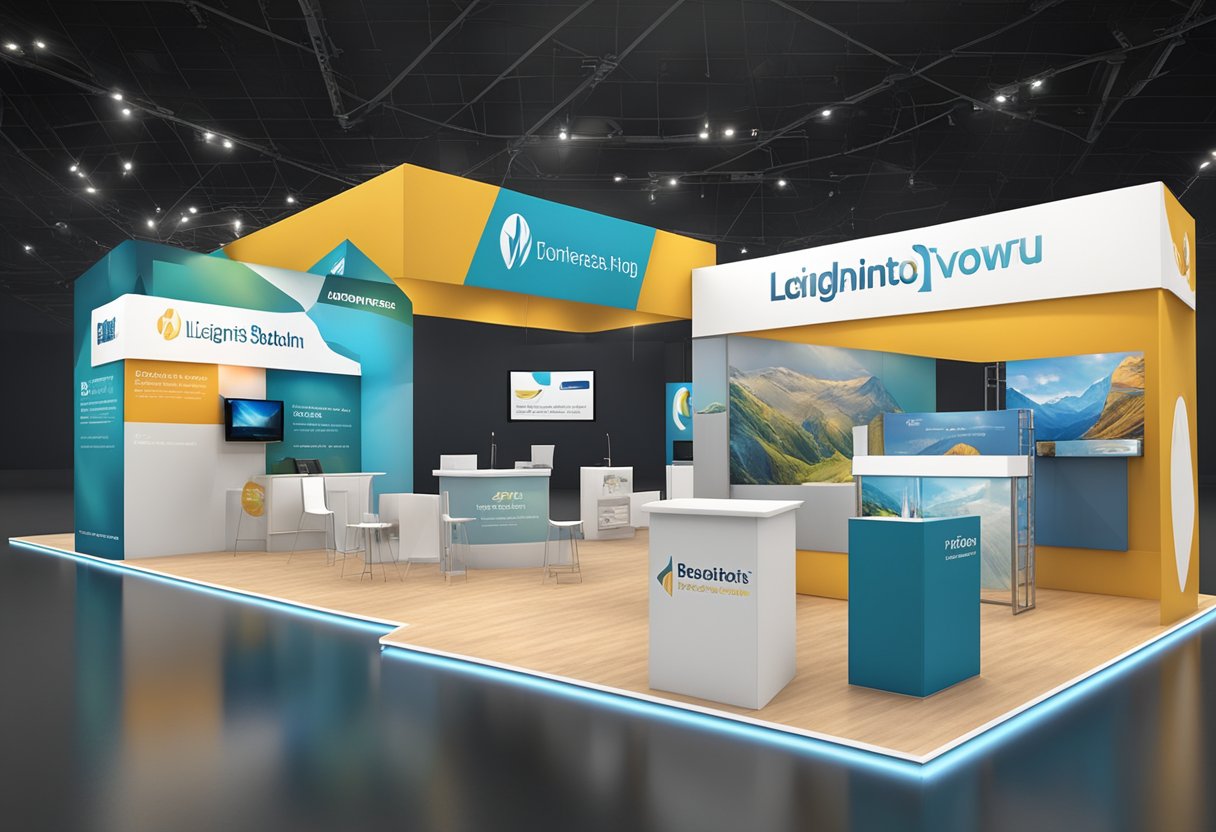
Planning for a trade show booth setup requires meticulous attention to details such as booth size, location within the trade show, as well as the logistics of transporting materials to the venue.
On-site execution involves staff training to ensure they are prepared to engage with attendees, deliver product demonstrations, and represent the company’s values. After the trade show, companies should review their performance, answering frequently asked questions, and gathering feedback to improve future trade show experiences.
Key Takeaways
- Effective booth setup and design are crucial for communicating a brand’s message and engaging attendees.
- Detailed planning and trained staff are vital for a successful on-site execution and interaction with visitors.
- Post-trade show analysis is important for measuring success and informing future trade show strategies.
Planning Your Trade Show Booth
Effective trade show booth planning is a strategic process that involves setting clear objectives, allocating a budget, and selecting the appropriate trade show to maximize return on investment.
Identifying Objectives
The first step is setting clear objectives for trade show participation. Objectives may include generating leads, increasing brand awareness, launching new products, or networking with industry partners.
It’s essential to have specific, measurable goals to guide all subsequent planning efforts.
Budget Allocation
Next, they need to allocate a budget that aligns with their trade show strategy and objectives.
This will involve listing all expected expenses including booth space, design and construction, marketing materials, travel, and accommodation.
It’s important for companies to anticipate these costs and ensure they have set aside funds to cover the full scope of the trade show.
Selecting the Right Trade Show
Selecting the right trade show is crucial, and this requires thorough research.
They should consider the trade show’s audience, the relevance to their industry, previous successes, and the potential for meeting their established objectives.
Trade show exhibits that impress are often part of well-attended trade shows that align with a company’s target market and goals.
Booth Design Essentials
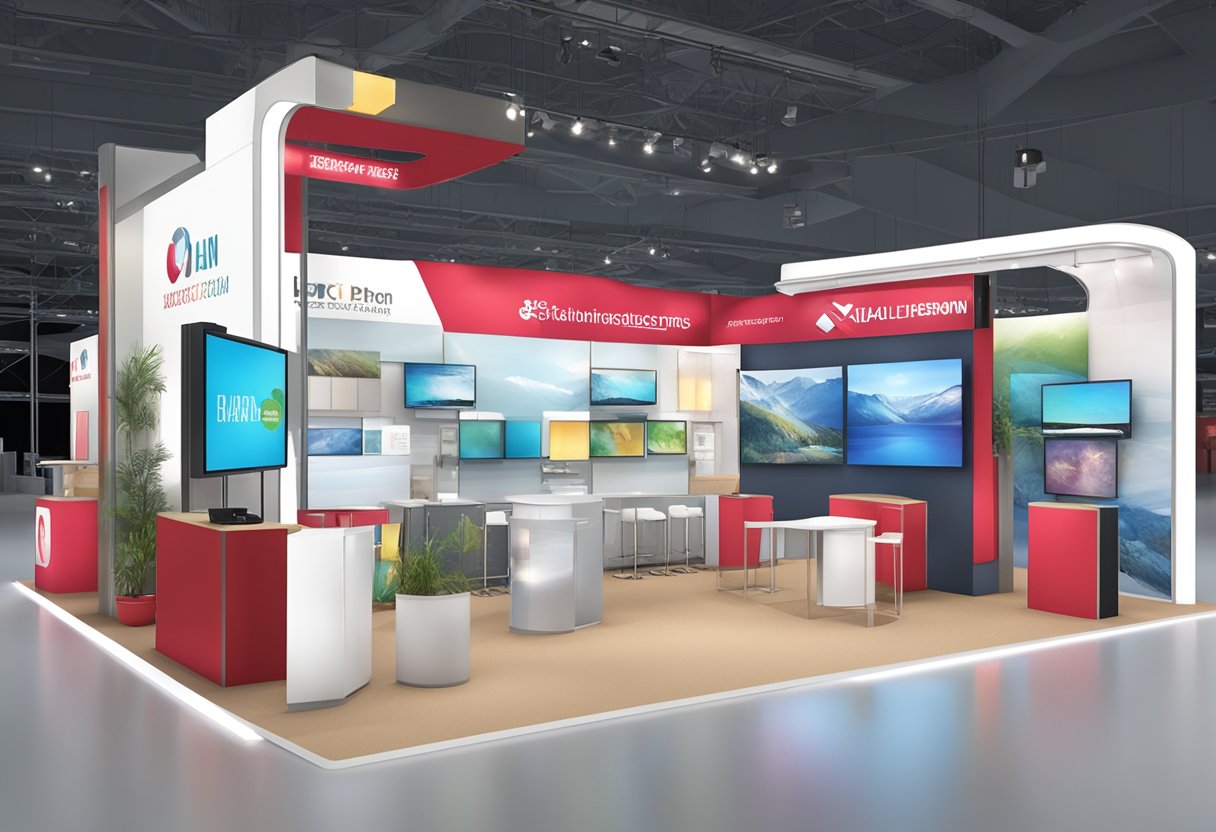
Creating an impactful trade show booth necessitates a strategic approach to design elements. An effective booth design can boost brand awareness and draw visitors, turning a simple space into a compelling representation of a company’s brand identity.
Maximizing Layout
The layout is the cornerstone of booth design, dictating the flow of traffic and ensuring that products or services are displayed prominently.
An effective layout considers the visibility of key offerings from multiple vantage points and maximizes the use of available space without creating clutter.
Incorporating graphics and signage in strategic locations can guide the visitor’s journey through the booth.
Incorporating Branding
Every aspect of the booth should serve to increase brand awareness.
This includes using consistent logos, messaging, and design motifs that align with the company’s brand identity.
It’s essential for all visual elements to resonate with the company’s core values and market positioning, creating a memorable and defining experience.
Choosing Colors and Graphics
Selecting the right color scheme and graphics is vital; they have the power to invoke emotions and associations with a brand.
The chosen colors should complement the company’s brand palette while ensuring high visibility in a busy trade show environment.
Moreover, high-quality graphics should reinforce the brand message and attract interest from across the show floor.
Engaging Visitors
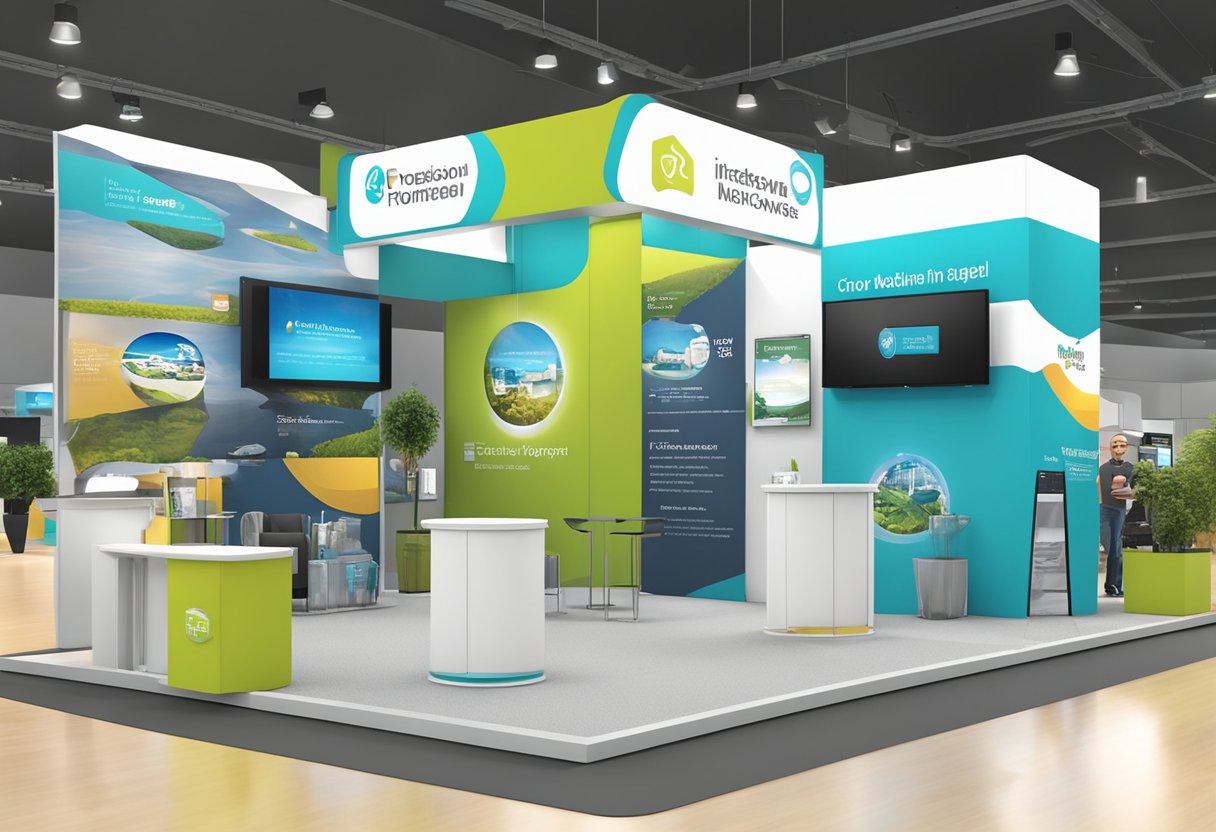
Effectively engaging visitors at a trade show is a strategic blend of interaction, promotion, and live demonstrations. By incorporating diverse elements, a trade show booth can become a vibrant hub of activity that both attracts and retains the attention of attendees.
Interactive Elements
Interactive features are essential for a dynamic trade show booth experience. They include:
- Games: Introducing games that resonate with the brand identity can make engagement both fun and memorable. Utilize technology like touch screens or VR to make it stand out.
- Contests: A contest with appealing incentives can increase the dwell time of visitors at the booth.
Tools like QR codes within the booth streamline the transfer of information, turning a casual stop into a potential sales lead.
Promotional Activities
Promotion should directly involve the attendees:
- Giveaways: Well-thought-out giveaways that are both desirable and branded effectively turn visitors into brand ambassadors.
- Exclusive Offers: Providing special deals or promotions to trade show attendees can generate immediate interest and longer-term customer loyalty.
Promotional items need to be selected with care, ensuring they connect with both the target audience and the core message of the brand.
Conducting Product Demonstrations
Nothing beats hands-on experience when it comes to product engagement:
- Live Demos: Placing products in the hands of visitors not only spikes interest but can also lead to direct feedback and stronger recall.
- Test Stations: Allowing visitors to test and interact with the products encourages deeper understanding and appreciation for their features and benefits.
In letting visitors test the products, companies can effectively demonstrate use cases and real-world applications, making the demonstration an integral part of the visitor experience.
Logistics and Setup
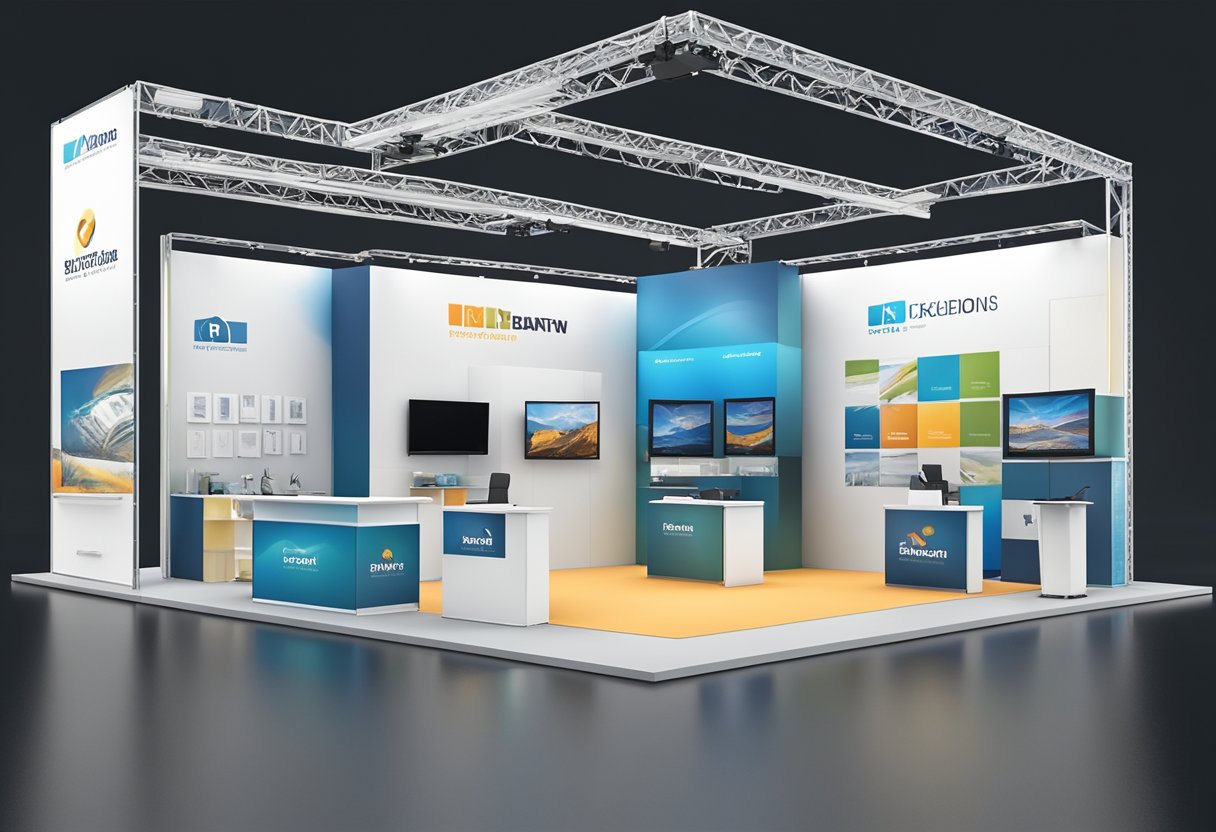
Effective trade show booth setup hinges on meticulous planning of logistics, precise assembly, and reliable technology preparation. These components must work seamlessly to ensure a successful exhibit.
Venue Preparation
When preparing the venue, it’s important to commence with a clear understanding of the space allocated.
Exhibitors should obtain a floor plan and visualize the layout of their trade show booth within the designated area.
They must ensure that the space is cleared of any obstacles or debris before installation begins. It is also vital to consider storage solutions for materials not needed during the show.
Booth Assembly Process
The assembly of the trade show booth is a critical phase that requires methodical execution.
The process starts with an inventory check to verify all components, such as panels, banners, and display materials, are present.
Every tool and equipment piece necessary for the assembly should be readily accessible.
Aligning the booth setup with the previously made floor plan ensures a smooth assembly process.
Technology and Equipment Setup
Integrating technology into a trade show booth can elevate its impact dramatically.
It involves everything from setting up digital displays to configuring multimedia devices.
Exhibitors should test all equipment—like screens, sound systems, and lighting—prior to the event to prevent any last-minute technical difficulties.
Moreover, ensuring all electronic devices are compatible with the venue‘s power supply is crucial for a seamless experience.
On-site Execution and Staff Training
On-site execution of a trade show booth requires meticulous coordination, while staff training is essential to engage effectively with attendees. This section details the nuances of team communication, customer interaction, and delegation of responsibilities.
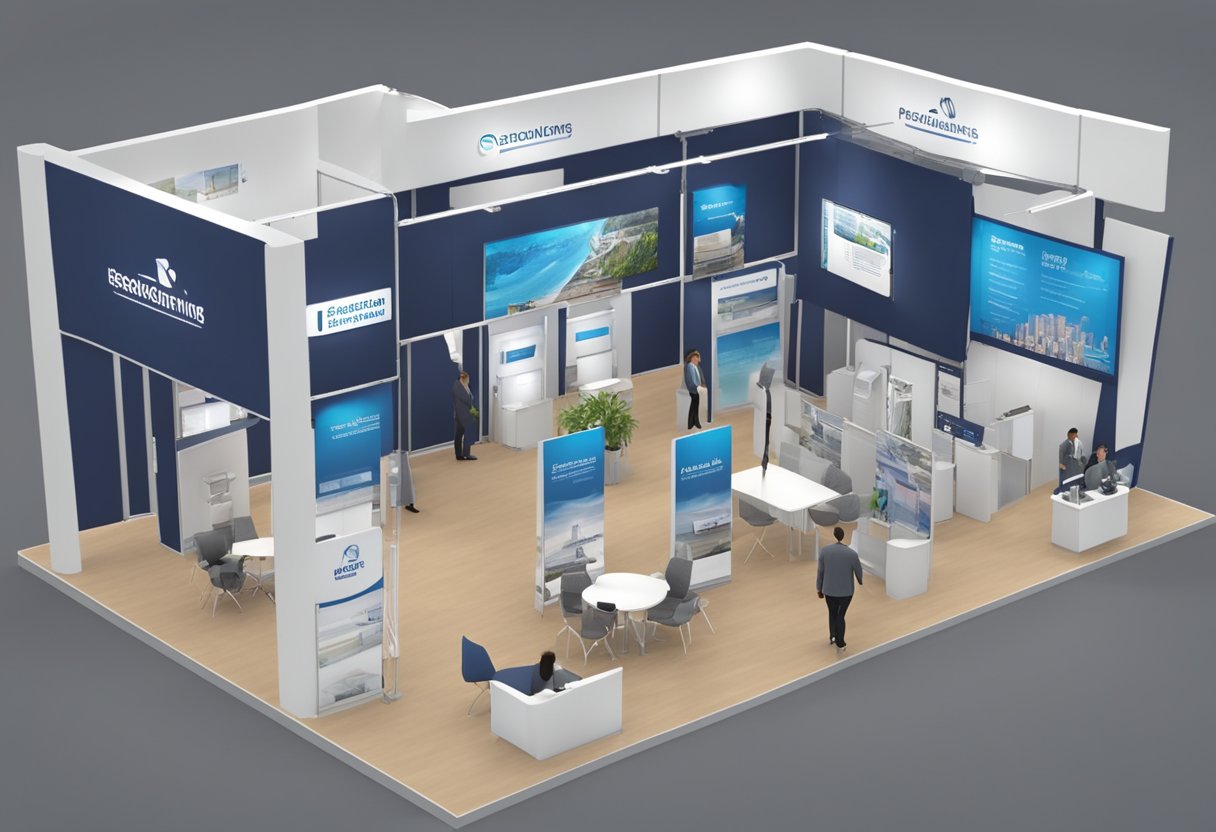
Effective Communication
For successful trade show participation, exhibitors ensure their booth staff is well-versed in effective communication practices.
Daily briefings are vital, setting the agenda and aligning the team on common objectives.
Employing clear, consistent messaging across all interactions not only supports brand consistency but also boosts confidence among staff members.
Handling Potential Customers
It’s critical for team members to have strategies for engaging potential customers.
An exhibitor’s ability to capture and maintain attendee interest can significantly impact lead generation.
Examples of such strategies include:
- Open-ended questions: Encourage richer dialogue with attendees.
- Active listening: Demonstrate to visitors they are heard and their needs understood.
Providing quick and accurate product demonstrations can turn casual visitors into potential leads.
Team Roles and Responsibilities
Efficient booth execution requires a clear definition of team roles and responsibilities.
A strategic approach involves:
| Role | Responsibilities |
|---|---|
| Lead Generator | Engage visitors and collect contact information |
| Product Expert | Provide in-depth product knowledge to attendees |
| Demonstrator | Perform product demonstrations |
| Greeter | Welcome visitors and provide orientation |
Each member of the booth staff should know their specific role to ensure a seamless attendee experience and effective booth operation.
Boosting Booth Visibility
To captivate the attention of trade show attendees, visibility is paramount.
Employing strategic signage and utilizing optimal lighting can set a booth apart in a crowded expo.
Incorporating digital displays into the mix can further enhance the booth’s allure.
Signage and Display Techniques
Effective signage is a lynchpin for increasing booth visibility.
Bold banners and clear signs that tower above the standard booth height can catch eyes from across the floor.
Materials chosen for signage should be of high quality and feature crisp, legible fonts, with company branding consistently applied.
Lighting and Visibility
Lighting has a dramatic impact on a booth’s visibility.
Use spotlights to illuminate key areas or products, and consider trade show light bars for an energy-efficient approach to keeping your booth well-lit and welcoming.
Strategic lighting not only enhances visibility but also creates an inviting atmosphere within the booth space.
Utilizing Digital Displays
Incorporating digital displays into a trade show booth setup introduces dynamic and interactive elements.
Screens can run product demonstrations or customer testimonials, providing a modern touchpoint that can draw and maintain visitor attention.
When deploying digital displays, ensure content is relevant to the audience and complements the booth’s overall message.
Marketing and Promotion
The success of a trade show presence hinges on effective marketing and promotion to captivate the target audience and foster impactful networking connections.
Through meticulous preparation and strategic outreach, businesses elevate their visibility and draw meaningful engagement within the trade show environment.
Leveraging Social Media
Social media stands as a powerhouse for trade show marketing, offering dynamic platforms to showcase marketing materials and engage a vast audience.
- Pre-Event: Businesses should announce their participation and booth number across platforms like LinkedIn, Twitter, and Instagram, generating buzz with countdowns and sneak peeks.
- During Event: Live tweeting, real-time updates, and interactive posts encourage attendees to visit the booth and engage online.
Using these tactics effectively creates anticipation and maintains a connection with the audience before, during, and after the event.
Pre-Show Marketing Strategies
Preparations before the event are crucial to ensure an impactful presence at the trade show.
Employing pre-show marketing strategies can prime the target audience and set a business apart from competitors.
- Direct Mail: Sending personalized business cards or brochures can alert clients and prospects about the business’s involvement in the trade show.
- Email Campaigns: A series of targeted emails with attractive graphics and compelling calls-to-action can nurture leads and inform recipients of what to expect at the booth.
These methods, initiated well in advance, lay the groundwork for a successful trade show by heightening awareness and interest.
Building Network Connections
Trade shows serve as a prime venue for expanding professional networks.
Key to this is the creation of opportunities for face-to-face interactions, where businesses can leave lasting impressions through direct engagement.
- Contact Exchange: Exchanging business cards remains a professional staple for follow-ups post-event.
- Immersive Experiences: Designing interactive elements within the booth can encourage deeper conversations with peers, industry leaders, and the target audience.
Focusing on these personal elements of connection reinforces business relationships and seeds potential collaborations or partnerships.
Engagement and Interaction
Effective engagement and interaction are essential for a successful trade show booth. They captivate attendees, foster connections, and can significantly amplify interest in your products.
Hosting Booth Activities
Trade show attendees expect more than just brochures and sales pitches; they are drawn to interactive experiences that are both fun and informative.
Hosting booth activities such as games can engage potential customers in a hands-on manner, creating a lasting impression of your brand.
For instance, a company could host a trivia game related to their industry, rewarding correct answers with promotional items.
Deploying Technology-enhanced Features
The inclusion of technology within a trade show booth can greatly enhance visitor engagement.
Deploying touch screens allow for interactive presentations of products and services, while virtual reality experiences can immerse attendees in environments that showcase your offerings in action.
Technology serves not just as an attraction, but as a tool for effectively communicating complex information in an accessible manner.
Creating a Memorable Experience
The ultimate aim of engagement and interaction at a trade show is to create a memorable experience for visitors.
This can be achieved through a thoughtful combination of sensory experiences – visually striking booth design, hands-on product demos, or even aromatic displays if applicable.
An engaging booth ensures visitors leave with a distinct and favorable impression of what your brand has to offer.
After the Trade Show
In the aftermath of a trade show, exhibitors are tasked with efficiently dismantling their booths, organizing transport, following up on new leads, and measuring their overall return on investment. This phase is crucial for maximizing the value of their participation and laying the groundwork for future opportunities.
Dismantling and Transportation
Once the trade show concludes, immediate attention is needed for the dismantling of the trade show booth.
Efficient disassembly is a sign of experienced exhibitors. They tend to have clearly labeled containers for individual components, which facilitates organized packing and prevents damage during transportation.
This step is not only about taking down the structure but also preparing for its secure conveyance to the next destination or storage facility.
Follow-up Strategies
After the trade show, a robust follow-up strategy is essential to capitalize on the leads generated.
A prompt response can often make the difference in converting leads into sales.
It’s recommended to categorize leads according to their potential and have a tailored follow-up plan, which may include personal emails, offers, or scheduling meetings to nurture the new relationships established during the trade show.
| Lead Category | Follow-up Action |
|---|---|
| Hot Leads | Personal Meeting |
| Warm Leads | Custom Offers |
| Cold Leads | Newsletters |
Measuring Success and ROI
To determine the success of their trade show presence, exhibitors must analyze key performance indicators (KPIs) related to goal achievement and return on investment (ROI).
This involves quantifying the cost of the booth set-up, staffing, travel, and other expenses against the revenue generated through sales and the value of the exposure gained.
They should consider both direct sales and long-term customer relationships that started with those trade show interactions.
Frequently Asked Questions
In setting up a trade show booth, certain key elements determine success; from essential components to design strategies, these FAQs tackle the foundational aspects for optimizing your exhibit.
What essential elements should be included in a trade show booth design?
An effective trade show booth design should include bold branding, clear messaging, and a layout that facilitates traffic flow. Providing interactive elements or multimedia displays can further engage visitors.
How can one create an engaging and effective pop-up display for trade shows?
To create an engaging pop-up display, focus on high-quality graphics and quick setup mechanisms. Lightweight materials and simplicity in design are paramount for flexibility and impact.
What are the best practices for maximizing brand visibility with a 10×10 trade show booth?
Maximizing brand visibility in a 10×10 booth requires strategic planning. Employ tall banners, leverage lighting effectively, and use high-contrast colors to make your branding stand out in a limited space.
What are some cost-effective strategies for setting up an impactful trade show booth?
Cost-effective strategies include using reusable modular displays. Also, focus on digital media. In addition, plan portable trade show booths. Lastly, create graphics that can be updated inexpensively for different shows.
How can custom design elements enhance the appeal of a trade show booth?
Custom design elements like tailored graphics, unique furniture pieces, and brand-specific color schemes create a memorable presence. This makes a trade show booth more inviting and reflective of the brand’s identity.
What are the key considerations when selecting a trade show booth kit?
When selecting a trade show booth kit, consider the kit’s ease of assembly. Also, think about its durability, adaptability to different spaces, and the inclusion of elements such as shelving, counters, and lighting that align with your exhibit goals.
